
Ken Russell
1927 – 2011
Photograph | 1988 ©Vestron Pictures / courtesy Everett Collection
When I think of British film director, Ken Russell, a number of words immediately come into my mind. The words or phrases I associate with Ken Russell are as follows:
Brilliant, British, Pushing The Envelope, Anti-Repression, Classical Music, Eccentric Artists, Obsessive, Auteur, Bombastic, Surreal, Genius, Avant Garde, Anger, Anti-Religion, Dark Eroticism, Carnal , Crass, Experimental Artist, Cultural Critic, Sardonic, Brutal, Human Lust, Lavish, Cinematography, Creative, Imaginative, Drug Culture, Transgressive Artist, Controversial, Intellectual, Form, Style, Orchestrated Chaos, Excessive, Angry, Provocative, Shock-Master, Sexually-charged, Kicking Against The Pricks, Unhinged Cinematic Master and An Original – in every sense of the word.

Ken Russell’s GOTHIC, 1986
Perhaps the greatest tragedy of Ken Russell’s artistic career is the fact that all of these aspects of the artist seldom blended to create that special alchemy that can form a masterful film. It seems as if these aspects that formed The Great Ken Russell also hindered him from being remembered as the Cinematic Genius he was. With the possible exception of only a few films, one has only to watch one of his films to see his genius at work. And with the exception of only a few, one only has to view one of his films to see how he most often undermined his own work.
There can be no question of the magic and inspired work found in such films as WOMEN IN LOVE, THE DEVILS and TOMMY. All three of these films capture almost every word or phrase that came to my mind, but all three of these film work beautifully on almost all levels.

WOMEN IN LOVE, 1969
Women In Love will always remain Ken Russell’s most accessible and commercial film.

The cast of WOMEN IN LOVE, 1969
A brilliant adaptation of the infamous novel by Larry Kramer, Ken Russell conjured a stunning cinematic experience.

The erotic eating of a fig. Alan Bates as Rupert in WOMEN IN LOVE, 1969
Glenda Jackson and Alan Bates were never better or more sensually attractive as they are in this movie. And the mix of Billy Williams’ cinematography, the music of Georges Delerue, the fine performances, sensual eroticism and Ken Russell’s obsessive care form a brilliant cinematic experience which fully captures D.H. Lawrence.

Glenda Jackson and Oliver Reed, WOMEN IN LOVE

Eleanor Bron, WOMEN IN LOVE, 1969

Oliver Reed and Alan Bates’ infamous nude wrestle.
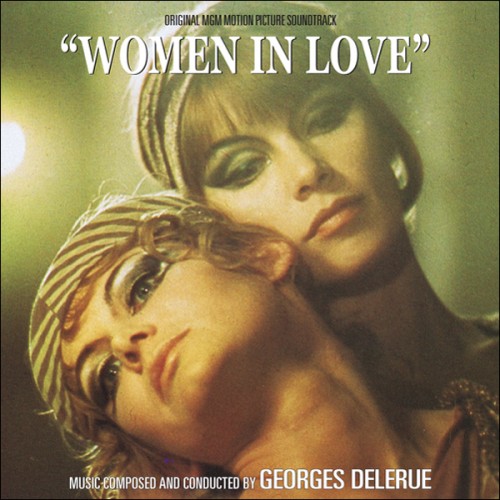
However, THE DEVILS may be a bit too brutal, angry, avant-garde and shocking to suit the tastes of many.

Vanessa Redgrave, THE DEVILS, 1971
THE DEVILS retains a major place in Film History and Film Theory. It also features the very early genius of Derek Jarman who served as Set Designer and contains one of Vanessa Redgrave’s finest performances. It is also impossible to see this film as Ken Russell intended. Though, there is a bootleg DVD out there that comes close. This film caused such controversy in it’s depiction of an actual historic event that it remains condemned by The Vatican. The infamous Rape of Christ sequence earned the film an X rating and outraged many. However, this motion picture remains a powerful – albeit convulsive, view of Vatican hypocrisy and the culture dangers of State and Church merging. THE DEVILS is a raging, bold, theatrical, surreal, repulsive, operatic and intentionally blasphemous indictment against not only The Catholic Church but organized religion.

Vanessa Redgrave’s Sister Jeanne love for Christ goes far beyond the appropriate scope. THE DEVILS, 1971
And, then Russell’s most commercially successful motion picture, TOMMY.

Your senses will never be the same. Ken Russell’s TOMMY, 1975
Though this film is very much a sort of 1970’s Glam Rock Time Capsule moment — it is a brilliant cinematic rock opera. Far ahead of the cinematic curve, it is hard to imagine the concept of the pop music video or the existence of MTV without Ken Russell’s TOMMY. The film was the perfect storm for a mid-1970’s hit.

Tina Turner as The Acid Queen about to rip his soul apart. TOMMY, 1975

Tina Turner is The Acid Queen about to apply the first of many injections. TOMMY, 1975
Acast filled with the coolest and most talented pool of rock musicians along with the Sex Kitten purr/roar of Ann-Margret.

Ann-Margret is The Mother.
TOMMY, 1975
In addition, TOMMY captures a great deal of the time in which it was filmed: cult religion, rebellion, sexual freedom, a growing understanding of the impact of trauma on children, the power of drugs for insight, the sexual revolution and the general unrest and anger seething in Wester Culture as the 1970’s moved to the mid-point.

Elton John is The Pinball Wizard.
TOMMY, 1975

That blind, deaf, dumb boy sure plays a mean pinball. Elton John, TOMMY, 1975
The story of The Who’s Tommy is given a whole new perspective from the 1960’s concept album. Ken Russell’s love of opera and all of eccentricities of his imagination were the perfect match for a rock opera. And, Ann-Margret was the perfect leading lady for him. Ann-Margret has always been a talented beauty, 
but has also also always come on a little oddly strong and theatrical. Her tempo and seething eroticism matched every turn of Russell’s camera. Her delivery resulted in an Oscar nomination for Best Actress in a leading role. A nomination that shocked as many as it pleased. In my opinion, TOMMY was Ken Russell’s finest hour as a filmmaker. It adheres to his aesthetic / style and offers him a chance to be commercial to the mass public. TOMMY was the perfect “trip” for the mid-1970’s.
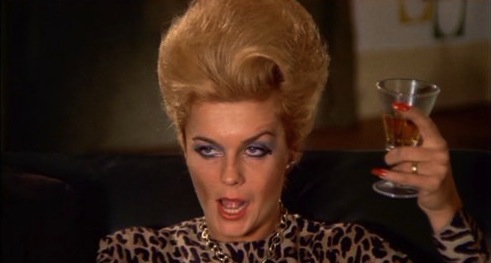
And, while it is now a bit dated, there is no way one can watch it without feeling the power of the film itself and note the ways in which it has been copied over the years. And, it is also impossible not to note that Ken Russell was inspired and enchanted by the physical / erotic presence and glam rock star look of Roger Daltrey.

Roger Daltrey is Tommy and a new muse for Ken Russell. Iconic and Erotic. TOMMY, 1975
One can’t help but suspect that it was his interest in Daltrey’s charisma and pop star status that moved him to make one of the most curious, strange and truly bizarre major Hollywood productions to ever find itself not only “green-lighted” but released to a world of mainstream movie screens…

Uh, oh. Roger Daltrey is Franz Liszt. Ken Russell’s LISZTOMANIA, 1975
There was already a very positive buzz surrounding Russell’s production of TOMMY. In the US, Columbia Pictures was already certain it had a massive hit coming their way. For the first time in his career, Ken Russell was truly being evaluated as a major player in the film business. Before he even finished filming TOMMY he knew he wanted to return to one of his favorite subject matters – the challenges and obsessions of the great classical composers. It has also been rumored that his perception of creating film had greatly been altered by his experience of working with The Who and interacting with the superstardom surrounding the band and the other rock musicians he had been able to cast in the movie. It is not surprising that he came up with the idea of what would become LISZTOMANIA. However, what is surprising is that Warner Bros. was so eager to get the movie made. What would have made the Big Warner Bros. “Suits” think that Russell’s script could ever be anything but a confusing mess is a cultural-head-scratcher. This is especially true when one thinks about the woes that their previous funding of Ken Russell’s THE DEVILS had caused them. True, that film was highly praised by some — but it is also true that it spurred equal amounts of anger. Audiences either loved THE DEVILS or hated it. One can argue that a work that can cause such extreme reactions is most likely a very valid work of art. But, this does not usually spell “blockbuster” — and, as with THE DEVILS, it resulted in being banned all over the world. But whether it was some sort of frenzy over the fact that TOMMY was destined to be a huge hit, or the drug-out culture pervading Hollywood at the time or just the simple idea that “the kids” will pay good money to see anything with the lead singer of The Who, rock music and the “weirdness” of TOMMY — Ken Russell’s next infamous feature was approved and set quickly into production. It is perhaps the biggest budgeted example of Experimental or Surrealism ever made by a major Hollywood studio.

Roger Daltrey is Franz Liszt and he is enjoying one of his groupies.
LISZTOMANIA, 1975
Ken Russell’s concept for the movie is not a bad one. Combined with his love of classical musical history, the creation of art, the cultural rebel and his new found interest in 1970’s Glam Rock Pop Culture — the basic idea of LISZTOMANIA is a seemingly valid and interesting cinematic idea. Anyone familiar with classical music history knows that Franz Liszt enjoyed a whole new sort of popularity during his lifetime. In the classical music “scene” of last quarter of 18th Century Europe, classical composers / musicians normally performed before a hushed audience who were there to take in the pleasure, power and essence of the music and “to be seen” — but Franz Liszt was inspiring something totally new in the world of performing arts. He didn’t just appeal to the wealthy. He appealed to almost everyone — particularly women. Reports of young women following him just to steal a tossed cigar or to catch a glimpse of their favorite composer.

Roger Daltrey in the prime of his Erotic Superstardom as Franz Liszt. LISZTOMANIA, 1975
And, many reports on record state that patrons often had a hard time concentrating on Liszt’s music due to the noise of the young women who would scream and push forward to the stage. Though, the word did not yet exist — Franz Liszt had a loyal fan following. And these fanatic “fans” would swoon and be totally swept away by his playing as much as his mere presence.
Heinrich Heine first coined the term, “Lisztomania” in 1844. Heine saw the reaction of Liszt’s following as becoming hysterical and falling into a “Liszt Fever” — audiences literally going crazy as he took to the stage. Swooning, dazed and applauding throughout his performances. Franz Liszt had “groupies” and apparently enjoyed the pleasure of their company.

LISZTOMANIA, 1975
Though, modern scholars would most likely warn that this was nothing like Western culture experienced in the early 1960’s with The Beatles. But, a valid argument can still be made that Franz Liszt may have been the first “Pop Star” — with one of compositions we now refer to as “Chop Sticks” being a signature piece he would perform to the delight of the young women.

Princess Carolyn rests on a somewhat oddly yonic bed while enjoying a joint as Franz serenades her with his magical music…
LISZTOMANIA, 1975
No doubt, Ken Russell saw the correlation between what is known about Franz Liszt and the 1970’s rock star. A rock star like Roger Daltrey. And, Ken Russell appears to take great joy in the meshing of costume with 1970’s Glam Rock fashion.

Franz Liszt about to leave the wife behind as he heads on to another lengthy tour. LISZTOMANIA, 1975

LISZTOMANIA movie promotion, UK. 1975
Unfortunately, Ken Russell didn’t stop with the Rock Superstar metaphor / allegory. After the creative energy and sheer delight of creating outrageous set pieces for TOMMY, he wanted to push his idea even further. Suddenly, the story of Franz Liszt was an opportunity to illustrate the hipocracy of The Vatican and the vile politics of The Pope. Here, Ken Russell had the “inspired” idea to cast Ringo Starr as The Pope. Religious icons were replaced with Pop Culture Icons such as modern rock and movie stars.
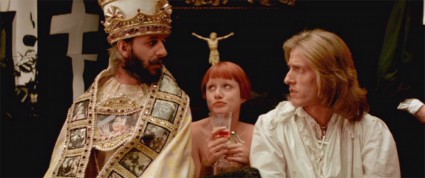
Ringo Starr is The Pope. LISZTOMANIA, 1975
And to examine the evil of humanity that would spawn Fascism and The Third Reich. Oddly, there is a valid connection here to the story of Franz Liszt. His daughter, Cosima, would go on to marry Richard Wagner – both were vehement anti-Semites and were part of an idea that would eventually lead to the creation of The Third Reich. An idea that would corrupt German culture and plant a seed that would grow into The Nazi. All of this historical information fueled Russell’s imagination and pulsated into a comic book re-telling of the horror of The Holocaust — featuring Richard Wagner as the Ultimate Evil Villain vs. Franz Liszt as The Ultimate Super Hero to fight and beat down the Oppressive Nazi “Superman”.
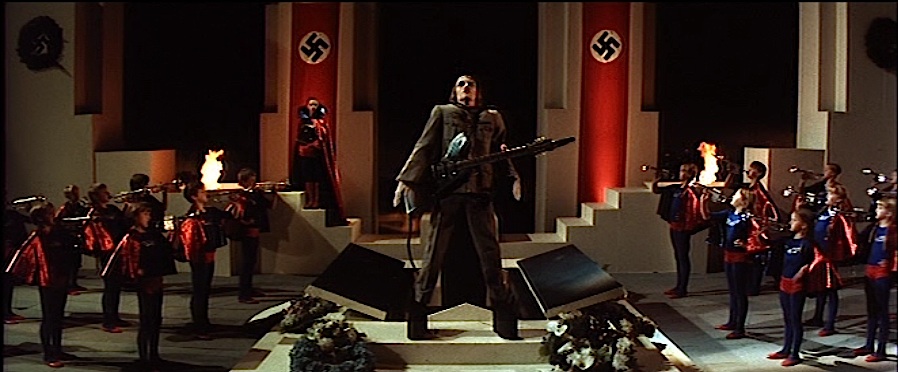
The Creation of Wagner’s Evil Nazi. LISZTOMANIA, 1975
On top of all of these strained conceptual ideas, Ken Russell wanted to create a world of cinematic pop culture. A Surrealist take on both history and the creation of art. And, of course, where their is a pop star there will be sex. Ken Russell’s LISZTOMANIA Is obsessed with sex and the erotic. It is also obsessed with cartoonish takes on phallus symbology. One can hardly keep up with the number of penis substitutes in the set and costume designs.
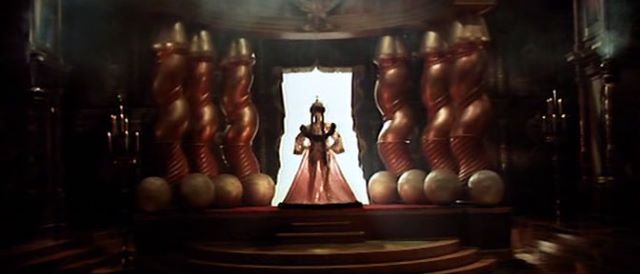
Are those columns or is she just happy to see Franz. LISZTOMANIA, 1975
The movie is also quite intent on pursuing yonic symbols. From simple heart shapes to a literal giant vagina that sucks Franz Liszt in to a swooping ride.

Franz about to be sucked into the tunnel of wet love. LISZTOMANIA, 1975
And, one of the strangest musical numbers involving the invoking of “Liszt True Muse” — his penis. …And, then chopping it off to free him of his ties to the carnal.

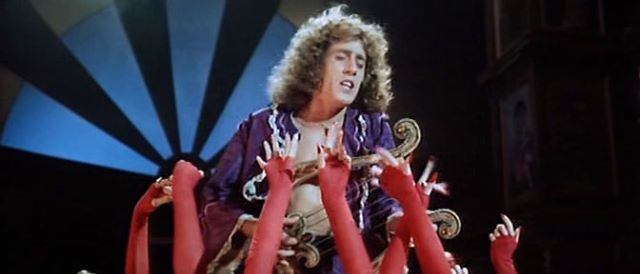

Uh, oh. Franz is getting turned on… LISZTOMANIA, 1975
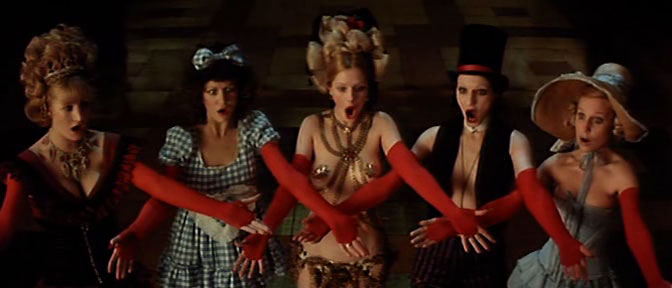
The historical figures / groupies are seeing Franz’s “genius” grow…

Taking a ride on the “genius” of Liszt… LISZTOMANIA, 1975

The musical boner…

Oh no! Time to chop it off!
In the end, once we come to the conclusion of Ken Russell’s film, Franz Liszt must die. And, only in death can he truly beat The Evil Wagner Monster. Surrounded by his lovers, muses and even Cosima — he leads his ladies in a rock ballad and then they all zoom off in a rocket back to earth to defeat Wagner’s Nazi Demon and rid the world of Evil.
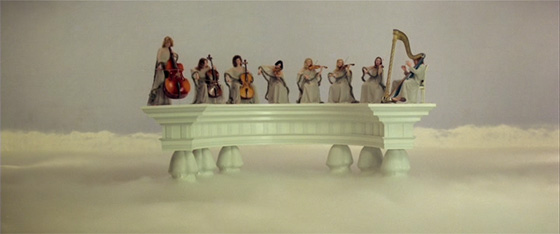
In Heaven, Franz leads his lovers in a rock ballad…

Before heading in a rather phallic “Organ” “Rocket” to kill the Evil Wagner Nazi! LISZTOMANIA, 1975
The camp factor is notched up to “13” by the time Ken Russell’s film comes to a close.
One of the few truly inspired ideas of Russell’s in this movie is the musical score. Rick Wakeman brings his electronica conceptual musicianship to the film and “reconstructs” Liszt compositions into the form of mid-1970’s rock. While not always creating radio-friendly tunes — the idea is inspired and well worth a listen. However, no amount of promotion could push this soundtrack into a hit recording. The soundtrack, along with the movie, has developed a hardcore fan base.

The Rick Wakeman / Roger Daltrey soundtrack album.
The soundtrack itself has an interesting back story. Worried that the music Wakeman and Daltrey had created would never sell, Warners sold the rights to A&M Records who quickly pushed Wakeman to tone down the music actually used in the film in hopes of making it more “commercial” — the result is an uncomfortable mix of classical music and middle of the road rock.
Close to thirty years later, Rick Wakeman, issued a more proper soundtrack of the film via digital version.

Rick Wakeman: The Real LISZTOMANIA soundtrack recording, 2003
This version preserves the more intense and insane concept of the musical score.

Erotic Exotic Fantastic – It out Tommy’s Tommy.
LISZTOMANIA promotion, Restricted, 1975
The really odd thing about this horrible film is that it is actually so bad it is entertaining. A jaw-dropping cinematic experience if ever there was one, Ken Russell’s totally unhinged and unhindered vision results in a true cinematic curiosity that can only be considered a massive cinematic error. However, the off-kilter balance of Yuk-Yuk Vaudville jokes, music, Avant-Garde sets and waked-out visuals are truly mind-boggeling. It is hard to not enjoy this film and it does enjoy a strong cult following. A couple of years ago a pristine DVD was issued in the UK featuring a commentary from Mr. Russell himself recorded about a year before his death. Sadly, while his sense of humor is strong — his memory seems to have faded and he offers very little insight into what was going on in his head when he crafted this film. Sadly, the DVD was only released in the UK. However, Warner Brothers Archive had made a remastered and letter-boxed DVD version available on its website. They print it by order — as they do with several Ken Russell titles. Tragically, Warners still refuses to officially re-issue any version of THE DEVILS. That film was released to VHS briefly in a severely censored version in the early 1980’s.
I can’t help but feel a great deal of love for this misguided movie. I am filled with wonder and inspired by the simple fact that a mainstream Hollywood studio not only financed this movie but pushed it forward with a great deal of fanfare. If you get a chance, you might just find yourself enjoying the absolute insanity of Ken Russell’s LISZTOMANIA.
As a side note, while he did promote it at the time of its release, Roger Daltrey has refused to ever publicly discuss LISZTOMANIA since a week after it’s initial release. I find that odd, but then again — not as odd as the movie itself.

It’s a wrap! And, Roger Daltrey is proudly carrying off a prop which was missing until a fan of Ken Russell met the director and confessed that he had the giant cock in his backyard. He would not tell Mr. Russell how he came to have it.
And, who knew Franz Liszt spoke with a Cockney accent?!?!!?



















































